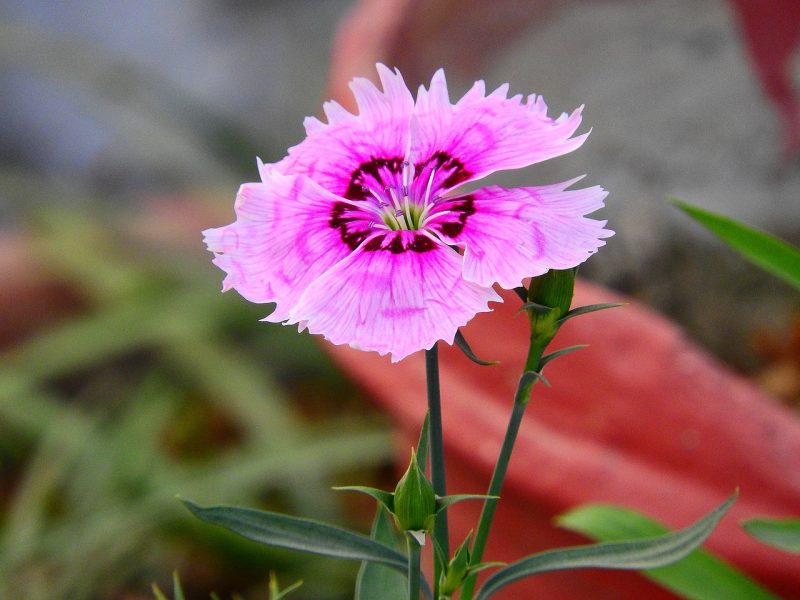Learning how to grow dianthus in pots in two easy steps will let you have these gorgeous carnations even without a large open space. More so, you can start them in the greenhouse and organize a collection of potted flowers with fabric pots. Later on, you can use the dianthus plants you’ve grown in another set-up as bedding.
Before you go on with the article, it’s worth noting that dianthus encompasses many plants, and you can choose from annuals, biennials, and perennials. It would also be best to select the appropriate variety or cultivar for your growing zone. Otherwise, use a greenhouse and adjust the environment to the ideal condition of your plants.

How To Grow Dianthus In Pots Successfully
Step #1. Medium and site preparation
The crucial consideration to guarantee healthy dianthus growth is the medium you choose. You want a fertile, chalky, and somewhat damp soil with a neutral pH. However, these traits can change depending on what dianthus you have as some species prefer acidic soil, while others have a different requirement.
More so, you may need a specific substrate that will provide the nutrients your dianthus plants need. To give you a general idea, gardeners opt for something with bark mulch or natural clay. Having perlite and peat should also improve the medium’s quality.
Where should you place your pots? Using the greenhouse for potted dianthus puts you at an advantage because the structure protects them from harsh climates such as wind and rain. However, the area should be sunny to create colorful and fragrant dianthus flowers.
Step #2. Planting and maintenance
The ideal time to plant dianthus is in spring or autumn, making sure that the danger of frost has passed or it hasn’t arrived yet. Always check your expected frost dates so you can place protection or start in the greenhouse if needed. To sow, press the seeds into the pot gently and maintain moisture throughout the germination period.
Dianthus flowers will eventually develop seeds that you can collect from potted plants. On the other hand, you can let the seeds fall into the ground if they’re in a garden, and they’ll grow well without much help.
Watering and feeding dianthus in pots
Each dianthus variety will differ in their watering and fertilizing requirements, so it’s best to check them first. However, dianthus plants generally tolerate some dryness. Watering would be ideal only when the medium gets dry to avoid overwatering that can cause issues.
On the other hand, you can fertilize during the growing season to encourage growth. Do this once a month, and you can also fertilize before they bloom in spring. Dianthus plants are not heavy feeders, so light fertilizing is enough for them.
Cutting dianthus in pots
Cutting the dead flowers, leaves, and stems in your potted dianthus plants is necessary. This way, your plant will have an easier time creating new blossoms as the withered parts don’t compete with the nutrients. You can cut back after the flowering period at around one-third of the plant to help with better growth for the next season.
Common Problems In Growing Dianthus
Regardless of where you’re growing dianthus, it’s best to be prepared with the common problems you might encounter. The good news is that these plants have no serious diseases that can set back newbie gardeners. Simple management practices like sanitation, proper watering, and maintenance of ideal conditions should help prevent fungal diseases and other problems.
Are dianthus plants prone to having pests? Perhaps all experienced growers of dianthus know how annoying greenflies are. Besides pest prevention practices, you can always look for organic insecticides, and they should be as effective as chemicals.
Propagating Dianthus
You can start dianthus plants in the greenhouse to guarantee growth. Depending on your variety, you can propagate from either cuttings or division. The process of either method is similar to how you’ll grow other flowering plants.
For example, gather dianthus cuttings with at least three leaf nodes, then root them in late summer or autumn for development after eight weeks. On the other hand, division is an excellent method if you notice an adult plant diminishing. Divide the plant before a new budding, and ensure that each section has buds.
Conclusion
You don’t have to give up having wonderful pink plants if you don’t have a large space. You’ll be surprised that learning how to grow dianthus in pots only takes two steps. First, choose the appropriate medium and location for the pots, which could be specific for the dianthus variety you chose.
Then you can plant the seeds by directly pressing them onto the soil and ensuring soil moisture to encourage germination. For the maintenance of potted geraniums, only water them when the soil is dry, and feeding would be ideal once a month during the growing season and before the spring bloom. You can also create better blooms by cutting back dead leaves, stems, and blossoms.
Lastly, you shouldn’t have any problem with pests and diseases in dianthus plants. They are not prone to severe diseases as long as you are diligent in management practices. But if you saw their common pest, greenflies, organic pesticides in the market would be a safe solution.
